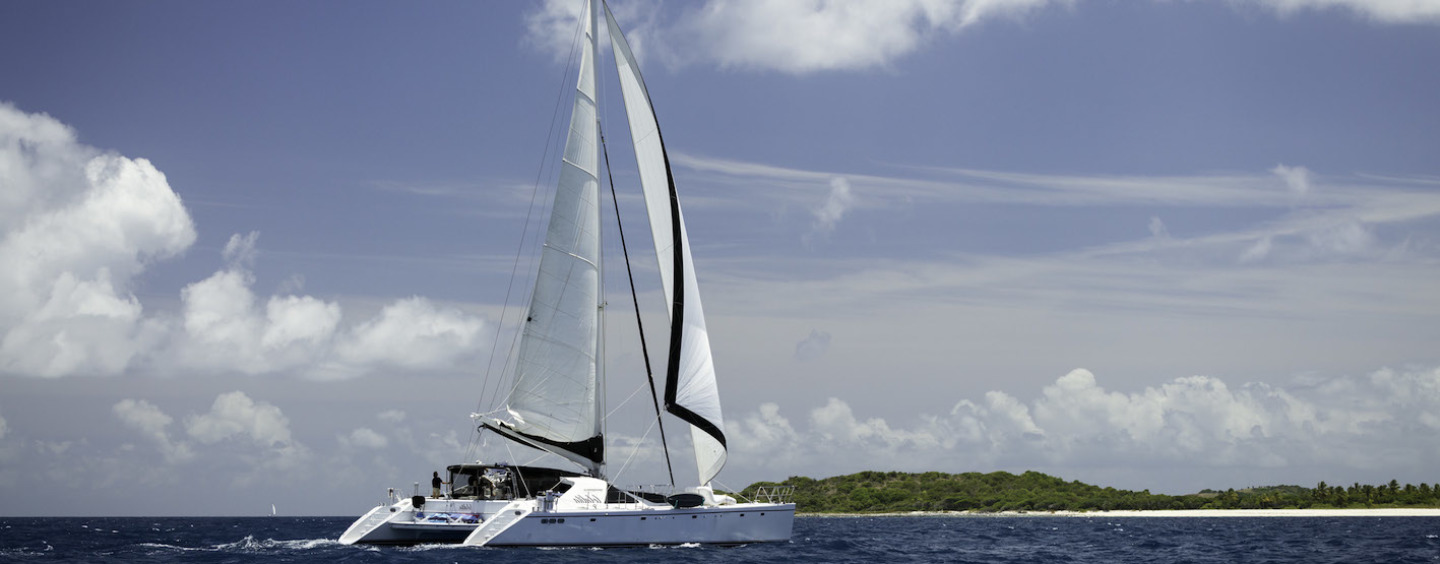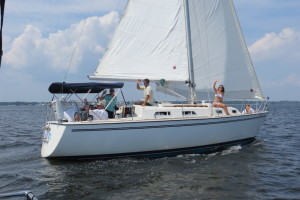Tossing up between a monohull vessel and a catamaran—maybe even a trimaran? Sorry, can’t help you! Monos, cats and tris are all great vessels, and each type has its strengths and weaknesses.
Which is faster?
There are many factors that influence the speed of a sailing vessel. These include total sail area, the cut of sail, the rake of the mast, hull shape, hull length, vessel mass, wetted surface area of the hull, and whether the vessel has a planing or displacement hull.
The basic principle of sailing is that a sail is foil-shaped, similar to an aeroplane wing. As wind passes across the sail or foil, the wind travels faster over the outside curve of the sail causing a low pressure system, which “pulls” the vessel towards the wind. As wind normally travels, parallel to the surface of the water, maximum drive from a sail is achieved when the leading edge of the sail remains perpendicular to the direction of the wind, i.e. when the mast is vertical.
Given the wide beam and low centre of gravity of multihulls, they do not heel as much as monohulls and therefore are generally much faster through the water (perhaps 25 percent faster comparing a mono and a multi of equal length), which is the reason why the America’s Cup boats have turned into catamarans.
To reduce heeling, many monohulls have a fixed-weighted keel to counteract the force of the wind upon the sail. Smaller yachts tend to have a swing keel, and must rely upon crew weight or ballast to counteract the same force.
The hull shape of yachts also plays an important role in vessel speed. A well-designed yacht hull can reduce the wetted surface area (the total area of hull in contact with the water) when the vessel heels, reducing the friction or drag of the hull through the water. The optimum vessel speed is achieved as a trade-off between maximum sail drive and friction through the water. Smaller catamarans can effectively half their total wetted surface area by completely lifting one hull out of the water.
Speed of a vessel through the water is not the only factor that determines whether a monohull or multihull will reach a destination first. The maximum angle a sailing vessel can point towards the direction of the wind will determine how many times a sailing vessel must tack. Tacking is generally a slow process in large sailing vessels. Vessel speed through the water can even drop right down to stationary during the tacking process. Monohulls can point higher into the breeze than catamarans, and monos generally lose less speed while tacking. In narrow channels and waterways, such as the Southport Broadwater, the higher a vessel can point into the breeze the better, as fewer number of tacks are required.
Vessel draught
The draught of a sailing vessel plays an important role in shallow waterways, such as the Southport Broadwater and its tributaries. Catamarans normally have short stubby fixed keels, allowing them to sail further outside the dredged navigation channels, which can help minimise the amount of tacking required. The reduced draught also allow access to shallower anchorages.
Monohulls with swing keels can also access shallow waterways when the swing keel is retracted. However, the vessel cannot be under sail when fully retracted. Monos with fixed keels can cause significant damage to the keel and hull if it strikes the bottom.
An advantage of a shallow-draft vessel is that you can purposefully beach the vessel to perform minor maintenance under the waterline. While removing barnacles on antifouled hulls when on the waterways is illegal, other maintenance such as inspecting the hull and propeller for damage, propeller replacement, anode replacement, transducer inspection, and rudder repair is a free option compared to the relatively expensive alternative of lifting your boat out of the water. Catamarans will remain level while beached (and trimarans almost level), which is a great advantage if you intend to sleep on board the vessel, use the galley, or use the head! Swing keel monohulls will list up to 45 degrees when beached, causing a very uncomfortable sleep and making time on board between tides a general misery. Fixed keel yachts are not intended to be beached.
Anchoring and berthing
Multihulls are more affected by windage than deep-draughted vessels. This can be of concern when anchoring in popular anchorages, such as Wave Break Island, Tipplers Passage, or Tiger Mullet Channel, especially when there is wind against tide. A vessel with a deep draught will be affected more by tide and current than wind, depending upon wind strength. A multihull and monohull anchored within the swing room of each other can certainly collide while both at anchor.
When berthing at a floating pontoon or a fixed jetty, a catamaran with dual engines will generally be easier to come alongside the berth, compared to a monohull without bow thrusters, or a trimaran with a single engine. If berthing at a marina, multihull owners may need to pay for two berths given the wide beam of their vessels.
Which has more room?
Given the shallower draft of multihulls compared to monohulls, multihulls will generally have less headroom inside the hulls than a monohull of equal length. However, if a multihull is of considerable length, then an enclosed cabin spanning the hulls is possible, allowing far more open space than a monohull. Deck space on a multi is also more than a mono.
Multihulls will generally have a greater passenger capacity than a monohull, which is why many commercial sailing operators prefer multihulls over monohulls.
Which is safer?
In the case of a catastrophic hull breach, a catamaran with one breached hull will be able to remain afloat if the other hull is intact. Both multihulls and monohulls should nowadays be constructed with multiple watertight bulkheads and adequate foam flotation to prevent sinking. However, this theory relies upon the quality of the manufacturer and modifications made to the vessel since manufacture.
In cyclonic seas, a monohull will handle the conditions far better than a multihull. Having said that, a multihull may be able to take advantage of its speed to avoid an approaching severe weather system by sailing around it.
In the event of capsize, a multihull will eventually become inverted and will be impossible to upright unassisted. However, a monohull with a sufficiently weighted keel should upright itself if it becomes inverted. Multihulls are harder to capsize than monohulls.
Catamarans normally have dual engines, which is an advantage over single engine vessels in case of engine failure.
What is more pleasant to sail?
When close-hauled, monohulls can heel severely, which can be quite uncomfortable to sit in for extended periods of time on long voyages. The heeling makes general duties, such as making coffee and preparing food, quite a challenge.
Catamarans can have a tendency for chop to slap the underside of the deck between the hulls, which can be quite loud and cause a shudder felt throughout the boat in moderate seas.
What should I buy?
Neither. I would hire them!
On a serious note, my only suggestion is to join several yacht clubs and multihull clubs as an associate member, and put an ad up on the club notice board as a crew member willing to sail on board as many types of vessels as possible, before investing heavily into your next adventure.
Southport Yacht Club, Royal Queensland Yacht Squadron, Multihull Yacht Club Queensland, and Queensland Cruising Yacht Club are popular sailing clubs in the Gold Coast and Brisbane regions.
What you primarily intend to use your vessel for will ultimately influence what type of vessel is best suited for you. Whether you intend to use your sailing vessel for racing or cruising (or perhaps a combination of both), entertaining guests, overnight or day trips, your sailing ability, and your budget will influence your decision.
By Nic Welch




























